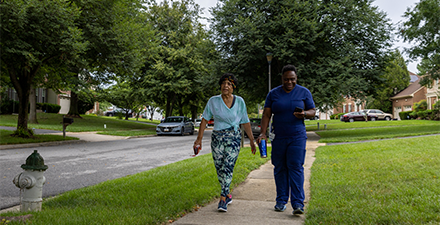Even though the National Institutes of Health's "Go4Life" month is wrapping up, the initiative will continue to offer resources to providers and the public. And for good reason.
Strongly supported by APTA, Go4Life is an ongoing effort to connect the public and health care providers with information and resources related to healthy aging. In addition to information on how exercise improves health, the Go4Life website includes suggested exercises, workout videos, fitness tracking resources, and access to printed materials including infographics, posters, bookmarks, and postcards, all available for free. The program also offers a free "Speaker's Toolkit" to help providers develop presentations to target audiences—available by emailing Go4Life@mail.nih.gov.
Of course, staying physically active for healthy aging isn't just a good idea—it's a concept supported over and over again by research. A lot of research. To give you an idea of the level of support for the positive effects of physical activity on aging, here's a quick overview of just some of the research articles that have been published on this topic during the month of September alone.
From the abstract: "Our results indicate that regular physical activity might be beneficial for preserving brain plasticity in higher age. In this study these associations were not mediated significantly by physical performance. Overall physical activity and exceeding current moderate to vigorous physical activity recommendations were positively associated with [brain-derived neurotrophic factor]. Sedentary behavior, however, seems to be negatively related to neurotrophic factor bioavailability in the elderly."
From the abstract: "These data suggest that sedentary time, higher intensity physical activity, and cardiorespiratory fitness should all be targeted in order to optimally reduce the risk for the metabolic syndrome and type 2 diabetes."
Physical Activity, Function, and Mortality in Advanced Age: A Longitudinal Follow-Up (LiLACS NZ). (Journal of Aging and Physical Activity)
From the abstract: "Higher levels of physical activity were associated with lower mortality and higher functional status in advanced-aged adults."
Repeated assessments of physical activity and risk of incident venous thromboembolism. (Journal of Thrombosis and Haemostasis)
From the abstract: "Our findings suggest that regular physical activity is associated with lower risk of venous thromboembolism, particularly in elderly. The association occurred at a low weekly amount of physical activity, and was only partly mediated by body mass index (BMI)."
Physical Activity and Incidence of Heart Failure in Postmenopausal Women. (Heart Failure)
From the abstract: "Higher levels of recreational physical activity, including walking, are associated with significantly reduced heart failure risk in community-dwelling older women."
Association between leisure-time aerobic physical activity and vitamin D concentrations among US older adults: the NHANES 2007-2012. (Aging Clinical and Experimental Research)
From the abstract: "Leisure-time physical activity appears to be an effective manner of maintaining adequate vitamin D concentrations later in life. Therefore, promoting physical activity in older adults should be a national public health priority."
Associations Between Objectively Measured Physical Activity, Body Composition and Sarcopenia: Findings from the Hertfordshire Sarcopenia Study (HSS). (Calcified Tissue International)
From the abstract: "Community-dwelling older adults in this study were largely sedentary but there was evidence that higher levels of activity were associated with reduced adiposity and improved function. Physical activity at all intensity levels in later life may help maintain physical function and protect against sarcopenia."
Home-Based Physical Activity Program Improves Depression and Anxiety in Older Adults. (Journal of Physical Activity & Health)
From the abstract: "A home-based physical activity intervention may be a viable treatment for reducing depression and anxiety in older adults with elevated baseline scores."
